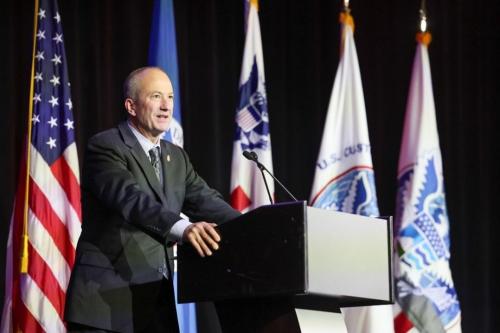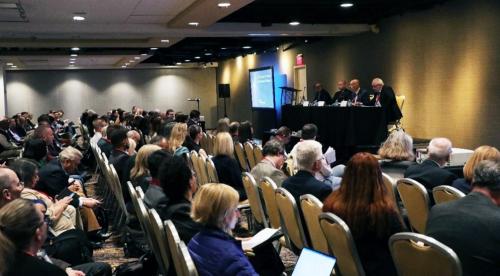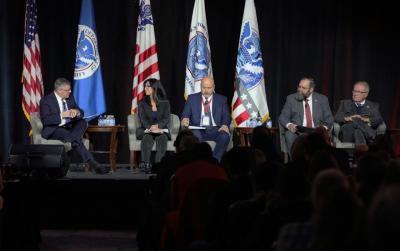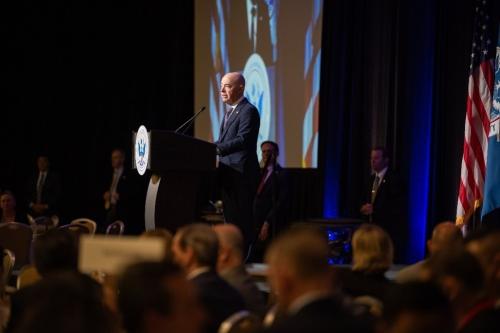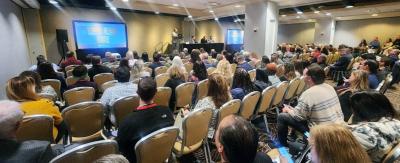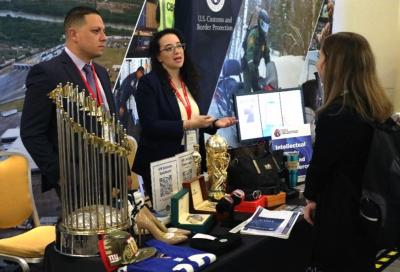
At a time when the U.S. economy is thriving, a standing-room-only crowd packed the halls of U.S. Customs and Border Protection’s Trade Facilitation and Cargo Security Summit on March 26-28 in Philadelphia. The three-day conference, which attracted 1,200 on-site and 3,000 virtual participants, focused on the critical need for strong communication and partnership.
“CBP remains committed to our partnership with you and the broader trade community. The Summit is an excellent opportunity for us to provide you with critical updates on our efforts, explore areas of shared interest, and hear from you on your priorities,” said Troy A. Miller, CBP’s Senior Official Performing the Duties of the Commissioner, who gave the opening address.
Miller spoke about the progress CBP has made. “We recently launched the Green Trade Incentives Analysis, a comprehensive research initiative, to identify meaningful incentives to minimize environmental harms and maximize environmental benefits of trade,” he said. On the intellectual property front, Miller shared that during fiscal year 2023, “CBP seized 19,522 shipments, containing nearly 23 million items in violation of intellectual property rights. The total estimated manufacturer’s suggested retail price of the seized goods, had they been genuine, is nearly $2.5 billion.”
In terms of forced labor, Miller reported that “CBP’s aggressive enforcement actions over the last four years have improved the working and living conditions for thousands of workers around the world. This enforcement has resulted in the repayment of over $62 million in withheld wages and recruitment fees to workers trapped in debt bondage. We are also seeing companies adjust their supply chains and enhance their due diligence. That is your impact,” said Miller. “Partnerships protecting the security, health, and economic vitality of the American people requires intense work and collaboration with everyone in this room.”
“Our partnerships make us stronger, more adaptable, and better prepared to meet the challenges of today and tomorrow,” Miller continued, citing Customs Trade Partnership Against Terrorism, CTPAT, as a prime example. “For over 20 years, the CTPAT program has been at the forefront of robust public-private partnerships to secure all of our supply chains. The program continues to play an integral part in our multi-layered cargo enforcement strategy, enabling CBP to prioritize the facilitation of secure and compliant trade.”
Leveraging technology
One of the major outcomes of partnership that Miller discussed is innovation. “The trade environment is constantly evolving and expanding. At the same time, we are continuously seeking to leverage technology to become more efficient and effective in our mission,” said Miller, noting that in fiscal year 2023, CBP processed over $5 trillion in combined imports and exports and collected more than $92 billion in duties, taxes, and other fees on behalf of the U.S. government. “Investing in technology innovation can help us manage these increases. We need to continue moving forward with our modernization efforts of the Automated Commercial Environment to ACE 2.0,” CBP’s cargo processing system.
Miller told attendees that in 2023, CBP had successfully tested technology and standards that assisted with origin compliance and product identification in the steel industry and affirmed preferential treatment under free trade agreements for oil transported by pipelines. “In 2024, we will expand our tests into the areas of e-commerce, food safety, and natural gas. But we need authorization, funding, and collaboration with industry and our interagency partners to really make an impact,” said Miller.
CBP also is investing in non-intrusive inspection technology, NII systems, that allows officers to detect anomalies in cargo and identify contraband and illicit goods more quickly. “Eight minutes compared to two hours for a physical inspection, which saves everyone time and money,” said Miller. “CBP is saving an estimated $1 billion in annual operating costs and the trade industry will save billions through improved efficiency and reduced delays.” Miller shared that CBP officers used large-scale NII to conduct more than 9.4 million exams, resulting in over a thousand seizures in fiscal year 2023. “These seizures included more than 50,000 kilograms of drugs and $2.5 million in undeclared U.S. currency.”
Miller also announced that CBP is partnering with the U.S. Food and Drug Administration, FDA, to expand testing of the Global Business Identifier, or GBI. “We are increasing our focus on supply chain traceability combined with facilitation. CBP will work jointly with the FDA to explore how identifiers could be leveraged to enable coordination and harmonized decision-making across the U.S. government. This could enhance predictability, lower costs, and create the opportunity for additional facilitation benefits for compliant trade,” said Miller. “I encourage our trade partners to participate in this test and voluntarily transmit your GBI data with your entry filings. Your feedback will help inform the ongoing evaluation of the GBI test, including potential benefits for filers.”
Miller went on to discuss CBP’s most pressing concerns such as the trafficking of fentanyl and other synthetic drugs. “Fentanyl is one of the gravest challenges we face now, frankly that we have ever faced. Combating the influx of these synthetic drugs will continue to be a top priority for CBP,” he said. The soaring rise of de minimis shipments, small packages with an aggregate value of $800 or less, is a related conundrum. “Currently, CBP processes approximately 4 million de minimis shipments per day, up from 2.8 million this time last year. This poses significant challenges for all of us as bad actors exploit this explosion in volume to traffic illicit goods,” said Miller.
“Over the past several months, stakeholders have raised concerns regarding the impact of de minimis on the textile and apparel industries, which is threatening industry domestically as well as in Mexico and Central America,” said Miller. “Concerns have also been raised about trade cheats violating the rules of our free trade agreements and the potential for cotton tainted by forced labor to enter our country through de minimis. We are taking these issues very seriously and we are interested in your feedback and your ideas. We are committed to ensuring that textile and apparel importers fully comply with applicable laws, regulations, quotas, free trade agreements and other preference programs to promote a fair and level playing field for U.S. industry,” said Miller. “We also know how important the textile and apparel industries are to our partners in Central America and Mexico, so we are working to ensure that bad actors do not sap the vitality of this critical industry corridor and impede the flow of legitimate goods.”
Combating illicit opioids
The summit featured many general sessions including a panel discussion on the Strategy to Combat Illicit Opioids. “Combating synthetic opioids is really nothing new. It’s something that we’ve fought for many, many years. What is different with the fentanyl fight is the sheer volume that we see, the way it’s being marketed, and the deadliness of this unbeknownst to the user,” said panelist Joseph Draganac, Director of CBP’s Fentanyl Campaign Directorate. “CBP adopted an all of agency unified approach to this fight. We brought all of our component offices together and really started strategizing.”
“But we understood that we couldn’t do this without collaborating with the trade community and industry,” said Draganac. “We understood early on that we would have to educate. We would have to share the trends that we were finding and say, ‘Hey, this is what we’re seeing. How do we work together to solve this problem?’ We put together a training program that CTPAT spearheaded with information from our enforcement operations — the trends, tactics, the way e-commerce was being exploited, where the gaps and loopholes are, and how companies could go back and look at their own internal supply chains to make them more secure.”
Draganac explained how CBP took the strategy further and established formalized memorandums of understanding so that information about seizures and removing entities from supply chains could be shared. Likewise, the information that was gleaned from the trade community could be given to CBP’s investigative partners to disrupt and dismantle criminal networks. “Establishing these ways of cross-information sharing has been key,” said Draganac.
Panelist Sean McStravick, Assistant Inspector in Charge of Contraband Interdiction and Investigations for the United States Postal Service, spoke about the U.S. Postal Inspection Service’s Southwest border initiative. “We’ve seen a 99% shift of synthetic opioids coming in from international venues to down along the Southwest border where they are being inducted into the mail stream. This is the fourth year that we’ve run a Southwest border operation. Essentially, we’re bulking up our staff for short periods of time to go to the Southwest border and try to interdict everything we can to get those narcotics out of the mail stream. Then we share that information with all of our partners. We target those particular parcels to make larger, more impactful investigations to truly dismantle these drug trafficking organizations.”
Artificial Intelligence and innovation
Another panel explored the topic of Artificial Intelligence and Innovation. “Artificial intelligence is something that is going to pervade everything that we do. It’s really taken off in a big way. In fact, some people have said that since the advent of electricity and the Internet, this is the most important invention in the last 50 to 60 years,” said Assistant Commissioner of the Office of Information and Technology, Sanjeev Bhagowalia, CBP’s Chief Information Officer, who moderated the panel. “We have been watching this very carefully. Some of us who went to engineering school studied neural networks. This is on a different level. This is so powerful it has the promise and the reality of computing data and all of the other things that we are doing in software, so it is going to be amazing, but also could be alarming.”
Panelist Thomas Mills, the Executive Director of CBP’s Cargo Systems Program Directorate, discussed ways artificial intelligence could assist the trade community. “We’re drowning in data in the trade space. We’re suffering from information glut,” said Mills. “Artificial intelligence can be used to look at regulations, logistics data, to analyze and identify patterns, trends, and to generate insights into how we could change rules and regulations.” Mills also explained that artificial intelligence could be used to generate documentation to facilitate trade. “Artificial intelligence could be that tool that helps with document reviews, verifications, and in a lot of instances, generate the documents that are needed in the customs process.”
Forced labor
The agenda also featured a panel discussion on Tackling Forced Labor in Global Trade and U.S. Supply Chains. Panelists shared their perspectives on the pervasive scale and scope of the highly complex issue. “The International Labour Organization recently released some new information on forced labor,” said Marcia Eugenio, one of the panelists and Director of the Office of Child Labor, Forced Labor, and Human Trafficking at the U.S. Department of Labor. “There are 160 million children in child labor around the world and 28 million people in forced labor. The recent information from the International Labour Organization indicates that illegal profits from forced labor are about $236 million per year. That’s an increase of about 37% over the last 10 years. So, we’re talking about a lot of illegal profits and a lot of people benefiting from the exploitation of another human being.”
Panelist Eric Choy, Executive Director of CBP’s Trade Remedy Law Enforcement Directorate, encouraged companies to know their supply chains and keep them free of products made with forced labor. “This is the time that industry should be working wholeheartedly to ensure that they are de-risking their supply chains,” said Choy. “Industry members that pay attention to the non-governmental organization, civil society, and investigative media reports in addition to doing their own due diligence are the ones who are getting ahead and are successful.”
Leadership perspective
Attendees also had a chance to hear from CBP’s senior leadership during a Town Hall-style panel. Each of the panelists spoke about the agency’s modernization efforts. James McCament, CBP’s Acting Chief Operating Officer who moderated the panel, opened the discussion talking about the agency’s plans for artificial intelligence. “CBP has been using artificial intelligence for several years to support some of our backend processes. We are now looking to move forward with artificial intelligence in ways that really help impact the trade community as well as the overarching partnerships that we have,” said McCament. “First, in building the framework of artificial intelligence governance and oversight at CBP, one of the roles that I am deeply engaged in, and also promoting the use of artificial intelligence to enhance our CBP operations and automate a lot of our administrative tasks. Giving back time to our CBP officers because time is money and it’s also security.”
Acting Executive Assistant Commissioner of CBP’s Office of Field Operations Diane Sabatino also spoke about the agency’s automation efforts. “We need to have tools that are informing individuals. The more information that we can put out in an automated fashion, the easier it is for us. We’re answering less, following up less because that information is available at our fingertips,” said Sabatino. “I was really excited to hear the panel talk about artificial intelligence. When we talk about the amount of data that we have and what our ability is going to be, to put terabytes of data at the fingertips of our frontline personnel in order to make smart, educated, and the most informed decisions possible, is going to be incredibly significant.”
AnnMarie Highsmith, the Executive Assistant Commissioner of CBP’s Office of Trade, also spoke about having the right tools. “We’re focusing our efforts now on supply chain tracing tool capabilities for us and for you, so that you can monitor your own supply chains,” said Highsmith. “A big emphasis right now is developing tools and techniques with regards to supply chain tracing because everything comes back to what’s in the box and how did it get here?” Highsmith also spoke about modernization tools for customs brokers. “We’re working with our brokers to ensure they have the right tools to help us do all the things we do—grow the economy, create a level playing field, facilitate legitimate trade, and keep bad stuff out. The brokers are very often our first line of defense.”
Another topic discussed was the early morning collapse of the Francis Scott Key Bridge in Baltimore after a support column was hit by a large container ship. “We know that CBP plays an important role both in the import and export of goods that come through that port. It’s a significant port for us,” said panelist Matthew Davies, Acting Director of Field Operations for CBP’s Baltimore Field Office. Davies noted that the Port of Baltimore is one of the country’s top 10 ports in terms of agriculture imports. “One of the real concerns with respect to the incidents happening in Baltimore today is looking at how we can work with the community, especially on the export side to make sure that there aren’t significant impacts to the export of certain commodities leaving Baltimore. Also, to make sure there’s not a major disruption more broadly to the global supply chain for both the exports and imports from an agriculture perspective.”
Additionally, during the Leadership Town Hall, Sabatino announced that Dina Amato, Assistant Director of Trade for CBP’s Miami/Tampa Field Office, will be the new Director of the CTPAT program.
The summit’s agenda also featured a sit-down interview with William Alan Reinsch, Senior Advisor at the Center for Strategic and International Studies, as well as notable speakers such as U.S. Department of Commerce Deputy Secretary Don Graves, who spoke about the breadth of the partnership between the Department of Commerce and CBP, which covers everything from antidumping and countervailing duties, export controls, and cybersecurity to international dialogues, intellectual property rights, and global supply chain security. “President Biden’s bold executive actions on supply chains opened up a new chapter in U.S. economic policy,” said Graves. “This includes the creation of the Council on Supply Chain Resilience as well as efforts to build a rapid reaction capability to assess, respond to, and resolve supply chain crises in real time.”
U.S. Treasury Department Secretary Janet Yellen also greeted the audience via a video message. Yellen explained that through various legislation the Treasury Department also has played a key role in bolstering the country’s supply chains. “We’re fueling massive investments in infrastructure and manufacturing that will strengthen our economic security. But our success also depends on our economic policy abroad,” Yellen said. “The Treasury Department has been focused on deepening our economic ties with key partners and allies to build stronger, more resilient, and crucially, more diversified supply chains. Deeper ties with a range of countries can advance our country’s economic security, bring benefits to American workers and firms, and increase economic opportunity around the globe.”
Yellen added that the Department of Treasury also remains focused on combating illicit trafficking of fentanyl and other cross-border crimes such as money laundering, which in turn contributes to drug trafficking and financing terrorism. “Treasury recently took a significant step forward with the launch of our Beneficial Ownership Information reporting system this past January,” said Yellen. “Across industries and sectors, we’re also focused on how to support American manufacturing, making sure American consumers can afford the goods they need and uphold the values we share with our allies and partners. All of this work depends on coordination across the U.S. government and with our counterparts abroad as well as extensive consultation with the private sector including many of you here today.”
Resilient supply chains
U.S. Department of Homeland Security Secretary Alejandro Mayorkas was the featured keynote speaker on the second day of the summit. Secretary Mayorkas spoke to the audience about supply chain vulnerabilities. “What redundancies do you have in place to prove yourselves resilient? What steps have to be taken to get you back up and running in full force? We now have a Supply Chain Resilience Center in our department. It is at a nascent, very formative stage, but we are very focused on the supply chain and its security, its integrity, and its resilience,” said Mayorkas. “I mentioned security and I mentioned integrity as distinguished from one another, and yet I want to be very, very clear that they are inextricably intertwined. A supply chain that lacks integrity we do not consider to be secure.”
Mayorkas also spoke about forced labor. “I understand the difficulties of identifying one’s supply chain at times, but I want to be very clear about something. We are charged as a department, and U.S. Customs and Border Protection most specifically, with the awesome responsibility of making sure that goods produced in whole or in part by forced labor do not enter the United States. That is a charge we have, and it is our obligation to abide by that charge. On this particular issue, make no mistake about it, we comply with that charge with tremendous, tremendous pride,” said Mayorkas.
“We will work with industry to assist you in identifying your supply chain, work with your partners in ensuring that your supply chain has integrity, but we will stop goods that are produced in whole or in part by forced labor. It is not only an issue of law enforcement. It is also an issue of human rights.”
Mayorkas concluded his remarks discussing partnership. “We take great pride in being in a partnership with the public that we serve, and that includes all of you, and very importantly, all of you who are central to our mission,” he said. “And if you find us to be less than an ideal partner in terms of our openness, our transparency, our communication, then you’ve got to let us know because partnership is built on trust and trust is earned. It cannot be earned without open and transparent communication. There are some things we’re not going to be able to share with you. We have law enforcement sensitivities, of course, but I think we build confidence when we communicate openly with you. And we are in the service business. We don’t serve a particular company. We don’t serve a particular broker. We serve the public. But you are members of the public and we’re really proud to partner and work with you.”
Breakout sessions
A variety of different breakout sessions were held on the second and third days of the trade summit. One of the panels focused on supply chain resiliency. “As we have seen in recent years, supply chains are susceptible to disruptions and by a number of causes. Whether it’s a natural disaster, conflicts, or a pandemic like COVID, where we faced shortages in personal protective equipment, or PPE, these events have serious impacts, not only to trade, but also to the economy and, ultimately, our national security,” said panelist Sanith Kimchrea, Acting Branch Chief of CBP’s Trade Modernization Division.
“Supply chain disruptions also are caused by cyberattacks, specifically, cyberattacks that target the trade community. In 2022, cyberattack incidents caused major trade system outages. Just one of those incidents impacted over $7 billion worth of goods,” said Kimchrea. “From fiscal year 2022 to fiscal year 2023, we have seen a 500% increase in cyberattack attempts. To throw another stat out there, CBP systems receive well over 100 million access requests per day. That’s up from about 45 million just a few years ago, and the trend is continuing to go up. So, it’s important to have a plan in place for when the inevitable happens because it really is a matter of when as opposed to if.”
Kimchrea had some takeaways for the audience. “CBP is the point of contact when you suspect you are under a cyberattack,” he said. “Reach out to CBP’s Security Operations Center at cbpsoc@cbp.dhs.gov.” Kimchrea also advised members of the trade community to visit the agency’s new cybersecurity resiliency website at cbp.gov/trade/cybersecurity-resiliency. “The website has guidance to refer to, including indicators of compromise or what to look out for if you think your system is experiencing a cyberattack.”
Panelist Bryan Smith, a Supply Chain Security Specialist at CBP’s Newark CTPAT Field Office had advice for attendees too. “We have had the opportunity to meet with many companies over the last four years that have gone through some sort of breach. Some of them fared well. Some of them did not,” said Smith. “One of the indicators of whether these companies fared well was if they had good, robust cyber security business resumption plans, crisis management plans, and if they rehearsed with tabletop exercises. It’s important that these exercises are rehearsed on a regular basis and that they include senior management. You really need to build that level of trust between your senior managers and all of the people throughout the organization that need to take action during crisis situations.”
Another breakout session focused on environmental and natural resource enforcement. Panelist Bryan Landry, the Assistant Special Agent in Charge of the National Oceanic and Atmospheric Administration Fisheries’ Office of Law Enforcement, shared a real-life example that highlights the seriousness of environmental and natural resource crimes. “Recently, in the last few years, an assassin for a drug cartel was arrested in Mexico, but not for his drug trafficking or the murders he committed. He was arrested for smuggling totoaba swim bladders,” said Landry. “Totoaba is an endangered fish that exists only in the Gulf of Mexico. Swim bladders are highly prized in the trade in Asia. So, gram for gram these dried swim bladders are actually worth more than any narcotic on the market today.”
“It did not take long for organized crime groups to realize that they can profit from these products and more than likely face less criminal penalties or risk than if they were caught with an equal amount of cocaine,” said Landry. “We have higher sentencing for drug crimes than natural resource crimes, so we’re increasingly seeing more of them.” Landry explained that environmental and natural resource crimes have always existed, but now law enforcement has become more focused on them. “Transnational crime organizations are engaged in illegal, unreported, and unregulated fishing; illegal logging; and wildlife trafficking. Because these are illegal commodities, there are associated financial crimes,” Landry said. “These criminals launder the money, because they can’t account for the proceeds from that illegal activity.”
Landry spoke about the importance of partnership. “With our small office, it’s especially incumbent upon us to work with the interagency. We really can’t do the work that we do without CBP and other agencies such as U.S. Fish and Wildlife Services and Homeland Security Investigations. If we didn’t work across the agencies, we wouldn’t get anything done.”
Likewise, due diligence on the part of the trade community is also needed, said Landry. “Due diligence is extremely important whether you’re importing timber, seafood products, or leather handbags. Understanding the chain of custody on where these products originated from to know if they are counterfeit goods or timber from the Amazon is essential,” said Landry. “I think what we are going to see in the trade realm is an increased onus on importers to do that due diligence. It’s not good enough anymore to just make sure there’s a permit or a piece of paper from the exporting country. This is a time where we’re going to need to look further into that source and ensure the trade is in full compliance.”



